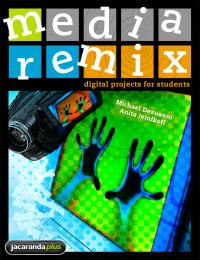Blogs, Wikipedia, Second Life and Beyond: From Production to Produsage
By Axel Bruns
Peter Lang, 2008
Reviewed by Michael Dezuanni
At the 2006 ATOM National Media Education conference, Axel Bruns gave a very well received presentation called Teaching the Produsers: Preparing students for User-Led Content Production, which can still be accessed in digital form on his blog:
http://snurb.info/node/604. It will come as no surprise to anyone who has seen the presentation that Bruns’ new book Blogs, Wikipedia, Second Life and Beyond: From Production to Produsage, provides an excellent theorisation of what is increasingly being referred to as participatory culture – the cultures and affordances of Web 2.0 that allow individuals to be producers as well as users of media content.
The central claim of Bruns’ book is that ‘produsage’ (a term he coined) is becoming increasingly prevalent in online, networked cultures and that produsage has the potential to radically alter the ways in which ordinary people interact with the media and a range of other social, cultural and organisational processes. Bruns traces practices of produsage through the open source software movement, citizen journalism and blogging, the writing and rewriting of the Wikipedia, the folksonomies associated with online tagging and filtering, the ‘life caching’ practices of photo-sharing sites like Flickr, the remix and mashup cultures of video sharing sites like YouTube and the user-led production of artefacts in video games and online environments like The Sims and Second Life. Along the way, Bruns discusses issues of access, copyright infringement and copyright alternatives like Creative Commons, the education of produsers and implications for politics and democracy. It is a far-reaching and comprehensive book.
Media teachers will be especially interested in the re-theorisation of the relationship between production and use of media, and the distinctions Bruns makes between the practices of the industrial age and those emerging in new media environments. At the heart of produsage, according to Bruns, are four key principles. Although these concepts seem a little theory-heavy when first encountered, they are extremely well explained and the examples provided make their implications very clear. The principles are: probalistic, not directed problem solving (problems are solved by many from the ground up); Equipotentiality, not hierarchy (authority exists, but through heterarchies and ad hoc meritocracies); Granular, not composite tasks (tasks are completed via small scale contributions); and Shared, not owned content (everyone benefits from access to the ‘product’).
The book does not focus a great deal on what media teachers might call ‘critical literacy’ questions about produsage culture or its social implications, and nor does it deal with broader questions related to some of the more controversial aspects of young people’s online experiences. For example, it does not discuss how produsage might relate to online safety, the ethics of self-representation, online bullying and so on. This is not a criticism – there is substantial critical thinking and analysis of processes, concepts and frameworks in the book. It is just that Bruns focuses on the more immediate issues of how produsage operates and its implications for the industrial models of media production, rather than on the social and cultural implications of produsage.
It would be fair to say the book is cautiously optimistic about produsage, but is aware of its limitations. Bruns sees great possibilities for ‘produsage’ practices to open up opportunities for a democratisation of media cultures so that individuals have more opportunities to be involved in the development of the cultures, knowledge and information they use. However, he cautions against being overly celebratory about this. He warns that for ‘produsage’ to be truly transformative, individuals need to be educated about how to participate and how to effectively ‘read’ the artefacts of produsage. For example, he argues that much of the controversy about the Wikipedia is a consequence of individuals trying to read it as a conventional encyclopaedia, therefore ignoring the entry histories available on the site, which provide a fuller sense of the definitions provided. What will be clear to educators who read this book is that media education needs to respond to participatory culture and the practices of produsage.
Media educators are in a unique position to respond to many of produsage’s possibilities and consequences. We have a head start in engaging students in digital media production and processes of critically reading media. However, produsage also raises a range of new challenges that will only become more pronounced as more young people engage in new media cultures. In particular, media educators need to grapple with the consequences and ethical dilemmas of young people having the almost unfettered ability to represent themselves and others in online spaces; to take the work of others and make it their own; and to distribute and filter their own and others’ work in online environments. In several ways, the priorities and objectives of media education courses will need to change in response to these developments.
I found Blogs, Wikipedia, Second Life… to be a highly rewarding read. I have not previously found an account that rivals this one’s explanations of those complex processes that we all suspect are ‘going on’ in online spaces, and yet struggle to understand. I have not previously read an account that has so effectively brought into relief the extent to which these new processes have the potential to change the media scape as we know it. I would recommend this book to all media teachers because it goes a long way to explaining the complex processes many young people are involved in and because it provides an indispensable introduction to participatory culture and specifically Bruns’ theory of produsage, which is likely to be influential within media education for years to come.




